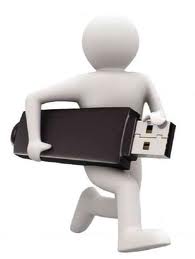
There was a time when we hardly had any mean to carry our important business documents with us while on the go, but then floppy disks emerged on the horizon giving the concept of portability which now has reached to a milestone. Now, we can literally carry gigabytes of data in our pockets without having to be loaded with huge piles and great chunks of paper data. Thanks to the advancements in the field of information technology that made it quite a possibility.
The introduction of USB drives has refurbished the whole idea of data portability that now almost everyone is carrying a flash drive which they use to store and carry information from one place to another.
USB flash drives have become more of a necessity than an option. These days, almost everyone whether it may be a businessman, a lawyer, a student or a home user is carrying a flash drive or a thumb drive.
Since the sizes of these storage devices are small enough that they can be carried in your pocket or in your hand bag, there are fairly prone to accidental loss or misplacement. For this reason, you should protect your USB drives and the data that they contain so that even if you lose them, you will be sure that the data remains inaccessible from unauthorized use.
Since, lost and stolen USB flash drives are the number one cause of privacy breaches, the best way to protect you from becoming a victim is to keep your USB drive secure either by using an encrypted flash drive or by using USB security software, which is an affordable solution. The finest plan of attack to secure USB drive is placing a password on your USB drive with the intention that every time somebody attempts to access your USB drive, it will ask for the password before giving access to anyone.
There are diverse safety procedures in the online market that let you protect your USB drives based on your own requirements and feasibility. You can find out many software which are designed to password protect USB drives while there is a software USB Secure which does not only let you password protect USB drive but all the other storage devices as well, such as pen drive, thumb drive, jump drive, memory stick and even external hard drive.
Can You Password Protect A Flash Drive?

Yes, you can password protect a flash drive. This is done by using encryption software such as BitLocker or TrueCrypt. These programs allow you to set a password that must be entered in order to access the files stored on the drive.
Password Protect Your Sandisk Flash Drive
The easiest way to password protect a SanDisk flash drive is to use software such as BitLocker or TrueCrypt. These programs allow you to set a password for your drive. To use either of these programs, you will need to download and install the software on your computer. Once installed, you can set a password for your SanDisk flash drive, which will be required to access the files stored on it.
Can Sandisk Secure Access Be Hacked?
SanDisk Secure Access is a secure file encryption software that is designed to protect data stored on SanDisk flash drives. It uses strong encryption to protect the data and is designed to be difficult to hack. However, no security system is perfect and there is always a possibility of someone being able to access the data if they have the right tools and knowledge.
Lock My Pendrive In Mobile
Unfortunately, there is no way to lock a pendrive in a mobile device. You would need to use a password-protected encryption program to protect the data stored on the pendrive.
Permanently Write Protect A Flash Drive
Permanently write protecting a flash drive can be done by using a dedicated software program. These programs are designed to encrypt the data stored on the drive, making it impossible to modify or delete the data without the correct password. Once the encryption is enabled, the data will remain secure even if the drive is removed from the computer. Additionally, some flash drive manufacturers offer hardware write protection, which can be enabled by a physical switch on the drive.
Make A Flash Drive Read-Only
Making a flash drive read-only can be done by enabling write protection on the drive. This can be done by using a dedicated software program or by enabling a physical switch on the drive. Once the write protection is enabled, the data stored on the drive cannot be modified or deleted without the correct password.
Lock A Flash Drive Without Bitlocker
There are several ways to lock a flash drive without using BitLocker. You can use a dedicated software program to password protect the drive, or you can enable hardware write protection on the drive. You can also use a physical lock to secure the drive, such as a combination lock or a key lock. Additionally, you can encrypt the drive using a third-party encryption program.
Alternatives Of Bitlocker
There are several alternatives to BitLocker that can be used to lock a flash drive. Some of the most popular alternatives include TrueCrypt, DiskCryptor, and VeraCrypt. These programs are all open-source and provide strong encryption for your data. Additionally, some flash drives come with their own encryption software, such as SanDisk SecureAccess.
Can A Hacker Break Bitlocker?
Yes, it is possible for a hacker to break BitLocker encryption. However, it is not easy, and the hacker would need to have a significant amount of computing power and specialized knowledge. Additionally, BitLocker has been designed with several security measures, such as two-factor authentication and encryption key splitting, which make it more difficult to break.
Encrypted Flash Drives
Yes, there are encrypted flash drives available on the market. These drives are typically encrypted using software such as SanDisk Secure Access, which provides a layer of security to protect sensitive data stored on the drive.
Can An Encrypted Flash Drive Be Hacked?
Yes, an encrypted flash drive can be hacked, but only with a significant amount of effort and specialized knowledge. The encryption used on the drive makes it extremely difficult to break, and even then, the data stored on the drive is still protected. Additionally, some encrypted flash drives may also have additional security measures, such as two-factor authentication, which further increases the difficulty of accessing the data stored on the drive.
Best Flash Drive Encryption
The best flash drive encryption is the Advanced Encryption Standard (AES). AES is a symmetric encryption algorithm that is used to secure data stored on a flash drive. It is widely considered to be the most secure encryption algorithm available, and is used by many government and military organizations. It is also used by many companies to protect sensitive data on their flash drives.
Are Sandisk Flash Drives Encrypted?
No, SanDisk flash drives are not encrypted by default. However, SanDisk does offer a range of secure flash drives that come with encryption pre-installed. These drives use either the AES or the FIPS 140-2 encryption standard, both of which are considered to be very secure.
Lock Your Pendrive Without Any Software
You can lock your Pendrive without any software by setting a password on the drive. This can be done by accessing the drive’s settings and setting a password. Once the password is set, the drive will be locked and can only be accessed by entering the correct password.
Is It Ok To Leave Your USB Stick Attached To Laptop While You Are Away?
No, it is not recommended to leave your USB stick attached to your laptop while you are away. This is because it is possible for someone to gain access to the data stored on the USB stick if it is left unattended. It is best to remove the USB stick when you are away from your laptop and store it in a secure location.
Which Lasts Longer SSD Or Flash Drive?
SSDs typically last longer than flash drives. SSDs are more reliable and durable than flash drives, and they can typically withstand more wear and tear. Flash drives can become corrupted or damaged more easily than SSDs, and they are also vulnerable to data loss due to physical damage. SSDs also have faster read and write speeds than flash drives, making them a better choice for long-term storage.
Lifespan Of A USB Flash Drive
The lifespan of a USB flash drive can vary depending on the type of drive, the amount of use, and the quality of the drive. Generally, a USB flash drive can last anywhere from three to five years with regular use. However, some drives may last longer if they are used less frequently and stored in a secure location.
Data Safety On A USB Stick
Data stored on a USB stick is generally safe for a few years, depending on the type of drive and the amount of use. Generally, data stored on a USB stick is safe for up to five years if it is used regularly. However, if the drive is not used often, the data can remain safe for up to ten years.
Secure My Usb Flash Drive
To secure your USB flash drive, you should use a password-protected encryption system. This will ensure that the data stored on the drive is only accessible to those who have the correct password. Additionally, you should store the drive in a secure location, such as a locked drawer or safe, to protect it from theft.
So, download USB security software in your USB secure, set and confirm a password and start keeping a secure USB drive while on the go!
